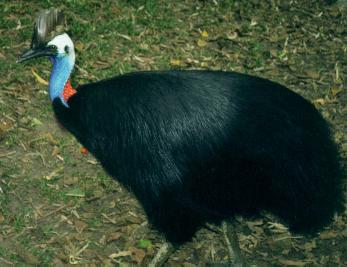


|
Casuariformes:
Casuariformes has four surviving members: the three species of cassowary, and the only remaining species of Emu. The emus were formerly classified in their own family, Dromaiidae, but are regarded as sufficiently closely related to the cassowaries to be part of the same family. All four members of the family are very large flightless birds native to Australia-New Guinea. The characteristics of the family are those of its members.
Systematics and Evolution:
The emus form a distinct subfamily, characterized by legs adapted for running. As with all ratites, there are several contested theories concerning their evolution and relationships. As regards this family, it is especially interesting whether emus or cassowaries are the more primitive form: the latter are generally assumed to retain more plesiomorphic features, but this does not need to be true at all; the fossil record is also ambiguous, and the present state of genomics does not allow for suffiently comprehensive analyses. A combination of all these approaches with considerations of plate tectonics at least is necessary for resolving this issue. The number of cassowary species described based on minor differences in casque shape and color variations is quite large. In recent times, however, only 3 species are recognized, and most authorities only acknowledge few subspecies or none at all. The fossil record of casuariforms is interesting, but not very extensive. Some Australian fossils initially believed to be from emus were recognized to represent a distinct genus, Emuarius, which had a cassowary-like skull and femur and an emu-like lower leg and foot. In addition, the first fossils of mihirungs were initially believed to be from giant emus, but these birds were completely unrelated |
